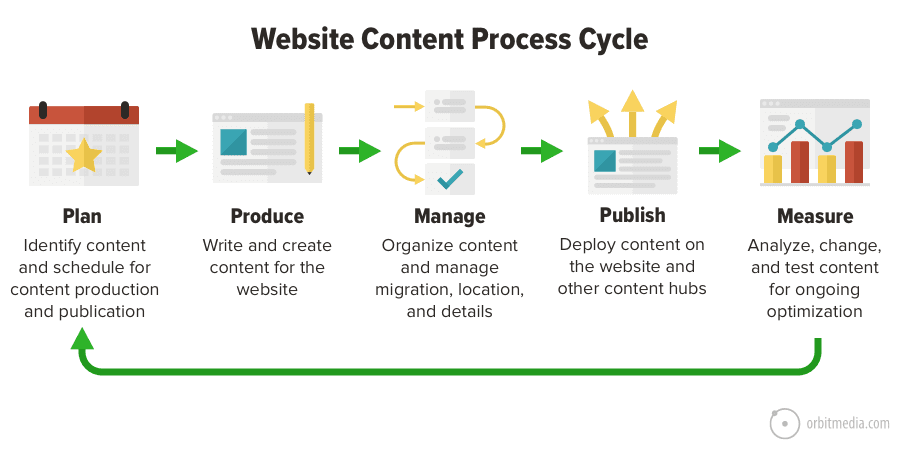Content is the number one reason web design projects are delayed. Creating new content, migrating existing content and managing assets is time-consuming.
While the threat of a blank page may always linger, there are a few easy steps you can take to wrangle the content process. In the end, the result – a website upgrade that increases traffic, qualified leads, and conversions – is well worth the effort.
What is the content process?
The content process refers to the creation, migration and management of content assets. For a website redesign, it means the pages, resources, images and other content needed to launch a site successfully.
The content process has five main components:
- Plan: Identify content and schedule for content production and publication.
- Produce: Write and create content for the website.
- Manage: Organize content and manage migration, location, and details.
- Publish: Deploy content on the website and other content hubs.
- Measure: Analyze, test and change content for ongoing improvement.

Each element overlaps with different stages of a website launch, which can add to the confusion. The vast quantity of content can feel overwhelming and unmanageable, making it difficult to corral. You’re also working on multiple projects and tasks, and the website is one important part of your complete marketing strategy.
After 1000+ projects, we’ve learned proven methods you can use to reduce the complexity of content management. These are our top five tips for managing content – from project beginning to launch and the day after.
1. Communicate throughout the content process
Managing content is no different than managing most anything: it requires collaboration, leadership, and communication.
- Set clear expectations around outcomes and objectives.
- Define and assign project roles and responsibilities.
- Set deadlines and schedules (i.e. define hours/week; budget and schedule time).
- Communicate regularly between deadlines.
- Define standards (i.e. templates, brand guidelines, style guides) and share them with everyone.
Every project should have a main point of contact to reduce confusion and set deadlines. While flexibility is important, defining the framework within which planning, production, and publication occurs helps every team member budget time and resources.
2. Prioritize content needed for minimum viable product (MVP)
Prioritizing content is an area where content teams struggle. A website is not a book; publication is not the finish line.
The best time to launch a new website is when it’s better than your old website.
Start by identifying what you have, what you want and what you need. With your inventory and plan in hand, you can begin to focus on your content process.
- Inventory content – what exists, what needs to exist, and where everything needs to go.
- Identify the most important pages needed for launch.
- Identify content that is “good enough” – for now.
- Identify after-launch content development goals.
Digital ink is never dry.
Once you shed the idea that a website is a finished product, you can better manage the vast elements of the content process.
3. How to organize the content process
A website redesign has many moving parts. While there is no “right” way to organize the content process, a smooth launch happens with some sort of organization in place. Whatever system or channel you use to communicate, share and organize files needs to be clearly defined.
- Collect your content assets – images, files, guidelines, etc. – in one place.
- Identify assets in the filename using standard terminology.
- Use folders or a hierarchical system to organize assets.
- Identify a standard process for sharing files and formats.
- Create a definitive method for tracking version history during the content lifecycle.
For example, we recommend images are cropped to certain sizes and specs, saved for web (72 dpi) in a zipped folder, assigned in page order and with a naming convention of name-of-page + page-order (i.e. homepage-header.jpg).
4. Coordinate approvals, feedback and workloads
When several teams are working together on a project, it is important to coordinate collaboration. This is true whether the teams are all internal (i.e. Marketing, Sales, & the C-Suite) or if there are third parties involved (i.e company & website host vendor).
- Set aggressive timelines (2-3 days) for feedback on project deliverables.
- Share the workload. The entire process cannot fall on one person.
- Define deliverables that require approvals.
- Clearly establish where different teams have the discretion to make decisions.
Setting clear expectations for content coordination is important. When teams understand how their action (or inaction) affects the project timeline, they manage time and resources more effectively.
5. Focus on the outcome and take things one at a time
Your website is your digital storefront – a brand message anyone can see. It can be an intimidating process, but the outcome is well worth the effort.
 |
andy crestodina, co-founder/CMO, Orbit Media“Content marketing is a funny thing. It’s the combination of a hundred little actions, each of which makes a difference. Just pick one thing every day and do it. It’s a game of inches!“ |
Stay focused on the outcome – a massive marketing upgrade – and break down the content process into manageable pieces.
And don’t hesitate to stop and acknowledge that website content management isn’t your only job. If the lift is too heavy, if the outcome seems unattainable, remember you don’t have to do it alone. Know when to take a step back and ask for help from folks who manage the content process day in and day out.
Manage the mayhem of the content process
The content on your website is incredibly important. It works hand-in-hand with user experience and design to move your site visitors from prospects to leads to customers. Lead nurturing is an essential element of your content strategy, and generating leads is an essential goal of your website.
Avoid having your project delayed by a mismanaged content process. Use these tips to help manage the content process and ensure as smooth a website launch as possible.
Another way to handle the complexity is to work with people who do this daily. At Orbit Media, we have dedicated Project Managers, Content Coordinators and Conversion Copywriters to manage the content process. Our standardized processes simplify the load you bear.
Choose serenity over calamity. Partner with Orbit.




